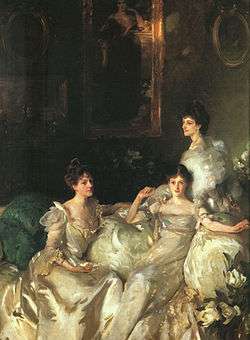The Souls

The Souls were a small, loosely-knit but distinctive social group in England, from 1885 to about 1920. Their members included many of the most distinguished English politicians and intellectuals.
The group formed as a response to the damper on social life caused by the political tension of the Irish Home Rule debate. Existing social circles were rent by angry arguments between proponents and opponents of the Gladstone ministry's efforts in 1886 to bring about full Home Rule. Many people in society wanted a salon where they could meet without fighting about politics. Wilfrid Scawen Blunt was a member of the group and gave a good, general description of the aims and objectives of its members, and above all, what they wanted to avoid. "In my disappointment about Egypt I turned with redoubled zest to my social pleasures of the year before, and at this time saw much of that interesting group of clever men and pretty women known as the Souls, than whom no section of London Society was better worth frequenting, including as it did all that there was most intellectually amusing and least conventional. It was a group of men and women bent on pleasure, but pleasure of a superior kind, eschewing the vulgarities of racing and card-playing indulged in by the majority of the rich and noble, and looking for their excitement in romance and sentiment." [1]
The name of the group was bestowed by Lord Charles Beresford, who is quoted as having said: "You all sit and talk about each other's souls — I shall call you the 'Souls'".
Among the original Souls were:
- George Curzon, 1st Marquess Curzon of Kedleston
- Arthur Balfour
- Margot Asquith
- St. John Brodrick
- Hugo Charteris, Lord Elcho
- Mary Charteris, Lady Elcho
- Alfred Lyttelton
- Percy Wyndham
- Madeline Wyndham
- George Wyndham
- Henry 'Harry' Cust
- Emmeline 'Nina' Cust
- William Grenfell, 1st Baron Desborough
- Ethel 'Ettie' Grenfell, Lady Desborough[2]
- Robert Windsor-Clive, 1st Earl of Plymouth
- Alberta 'Gay' Windsor-Clive, Lady Windsor
- Henry White, the U.S. diplomat
- Violet Manners, Duchess of Rutland, and her daughter by Cust, Diana
Also prominent in The Souls were the five Wyndhams (children of Percy Wyndham): George, a politician and writer; Guy Percy, a soldier; Madeline, who married Charles Adeane; Mary, who married Lord Elcho; and Pamela, who married Edward Tennant, Margot Asquith's brother. John Singer Sargent painted a joint portrait of the three Wyndham sisters, as well as an individual portrait of Henry White's wife, Margaret.
This original group of Souls reached its zenith in the early 1890s, and had faded out as a coherent clique by 1900.
The Coterie
The Coterie was often considered as the second generation of The Souls. They were a mix of aristocrats, politicians and art-lovers. They were patrons of artists of the time, including Edward Burne-Jones and James Whistler.
References
- ↑ Wilfrid Scawen Blunt, My Diaries; Being a Personal Narrative of Events 1888–1914. Part One: 1888–1900 (New York: Knopf, 1923), p. 53.
- ↑ "Revelations of Ettie Desborough, an Edwardian A-lister". Mail OnLine. 8 August 2008. Retrieved 1 February 2016.
Further reading
- Abdy, Jane and Charlotte Gere. The Souls. London : Sidgwick & Jackson, 1984. ISBN 0-283-98920-3
- Ellenberger, Nancy W. Balfour’s World: Aristocracy and Political Culture at the Fin de Siècle. Woodbridge: Boydell & Brewer, 2015. ISBN 978 1 78327 037 8
- Lambert, Angela. Unquiet Souls: The Indian Summer of the British Aristocracy, 1880–1918. London: Macmillan, 1984.
- Nevins, Allan. Henry White: Thirty Years of American Diplomacy. New York: Harper & Brothers, 1930.